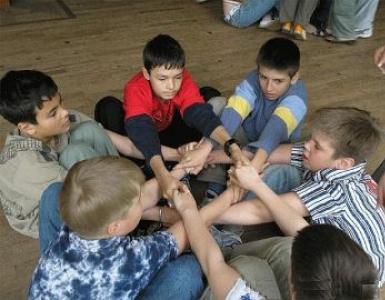Drawing of the German assault rifle Schmeisser stg 44. Information desk: About the monuments to Schmeisser and Kalashnikov
Plan:
- Introduction
- 1 Prerequisites for drought
- 2 July and August 1972
- 3 Fighting the elements
- 4 Press coverage Notes
Introduction
Drought in the USSR in 1972- a complex of unfavorable weather conditions observed in June-August 1972 in the central zone of the European part of Russia. The summer of 1972 was unprecedentedly hot and dry throughout the European part of Russia; in some areas of central Russia, practically not a drop of precipitation fell.
1972 was the only year in Moscow where all three summer months (June, July and August) were warmer than normal. Also, this year's drought was the most severe in the entire 20th century.
The severe drought has caused severe forest fires. In 1972, 6,500 square kilometers of forest burned in the RSFSR (about a seventh of the area of the Moscow region). In the Moscow region alone, fire burned 19 villages, killing 104 people. Dyakov, Anatoly predicted drought based on observations of the Sun.
1. Prerequisites for drought
The winter of 1971-1972 was severe and relatively light in snow. Severe frosts persisted in Moscow until mid-March. As a result, the soil was unable to accumulate large quantities moisture reserves.
Already in May-June 1972, soil drought began to be observed. Due to drought, spring wheat, barley, and oats died. Winter crops survived in some places where there was a fairly large snow cover in winter.
2. July and August 1972
Unprecedented heat came to central Russia after the formation of the so-called “blocking anticyclone,” which occurred in the first ten days of July. At the same time, the last precipitation fell.
During the summer of 1972, the temperature exceeded +30 °C in Moscow 26 times, and only 82 mm of precipitation fell in the summer, of which 62 mm fell in June. During July and August, only 20 mm of precipitation fell.
The drought broke out shortly after the arrival of the anticyclone. For a month and a half, practically not a drop of precipitation fell. Fires of peat bogs and forests began, and Moscow was shrouded in smoke for a long period of time. The army was brought in to put out the fires, but the fires destroyed entire villages.
The smog was so dense that it was impossible to see the other from one bank of the Moscow River.
The drought covered an unprecedented territory - the Volga region, where the heat reached almost 40 °C, the Urals, and to a slightly lesser extent - the North-West of Russia. However, in Moscow, probably due to heavy smoke, the temperature never reached 35 degrees, and at night sometimes dropped below +10 degrees.
August 1972 became unusually warm and dry throughout European territory, and is the warmest until 2010 for Moscow ( average temperature+20.6 °C), and Kharkov (average temperature +23.9 °C), and a number of other cities. July 1972 was the warmest until 2010 in Leningrad (St. Petersburg) (average temperature +22.1 °C).
Extreme heat also affected southern Russia. In some places not a drop of precipitation fell.
The drought gradually moved from the southern regions of Russia to the north, as the anticyclone spread and intensified.
3. Fight against the elements
Due to peat fires, Moscow was shrouded in smog. In 1972, 6,000 hectares of forest burned in the Moscow region, and more than 3,000 forest and peat fires were recorded. Smog stayed in Moscow for at least a month. People could not leave the house; they could not breathe.
The situation with peat fires was critical. The army was brought in to extinguish them, but the situation was only reversed on August 23, when the blocking anticyclone disintegrated, and all the fires were finally extinguished only by September 10.
For Soviet Union drought became a real disaster. Purchases of grain abroad began, and an air conditioning plant was opened for the first time in Baku. Gold and foreign exchange reserves were spent on the purchase of grain - 486 tons of gold were sold abroad (≈22 billion dollars at the current cost of gold).
More than 30 thousand volunteers were recruited to extinguish the fire, including collective farm workers, workers, police officers and 24 thousand firefighters. Earth-moving vehicles were used (almost 15 thousand self-propelled earth-moving vehicles) and more than two and a half thousand fire engines and pumping devices, which worked continuously for 14-20 hours a day. The volume of water that was poured onto the fires from above and pumped into the burning peatlands using pipelines was about 90 thousand tons per day.
The fight against the fire was controlled by the Politburo of the CPSU Central Committee, and the extinguishing was headed by the Minister of Defense of the USSR, Marshal Grechko, who settled for almost two months in Shatura, near Moscow, which became the center of the fires. The most difficult situation developed in Shatura, Orekhovo-Zuevsky, Yegoryevsky, Noginsky and Pavlovo-Posad districts Moscow region . In addition to the Moscow region, the fire raged in Tver, Vladimir, Kostroma, and to a lesser extent, in other regions.
4. Press coverage
The press paid relatively little attention to the drought. Photos of this natural disaster were rarely published in newspapers, and events related to fires were sparingly covered on television. However, it was not possible to completely hide information from the population. A gathering of volunteer detachments was organized to extinguish the fires. There was large-scale propaganda regarding the medical side of the incident, but there were still recommendations - do not go outside unnecessarily, wear a gauze bandage and drink plenty of fluids.
Notes
- 1 2 3 4 Weather in Moscow in August 1972 - thermo.karelia.ru/weather/w_history.php?town=msk&month=8&year=1972
- 40 years ago, meteorologists said the same words about the causes of heat - news.gismeteo.ru/news.n2?item=63417213582
- Fires in the Moscow region in 1972 - eco.rian.ru/ecovideo/20100806/262064030.html
- Yuri Rost. Article about Dyakov - www.yury-rost.ru/portrets/century/item9/
- Weather in Moscow in January 1972 - thermo.karelia.ru/weather/w_history.php?town=msk&month=1&year=1972
- Weather in Moscow in March 1972 - thermo.karelia.ru/weather/w_history.php?town=msk&month=3&year=1972
- 1 2 Weather in Moscow in July 1972 - thermo.karelia.ru/weather/w_history.php?town=msk&month=7&year=1972
- Summer 1972. How it was - news.gismeteo.ru/news.n2?item=63417213582
- Video of the first channel. As it was 38 years ago. - news.gismeteo.ru/video.n2?item=63417203529
- Smog 1972 - www.1tv.ru/news/social/159175
- Weather in Saratov in July 1972 - thermo.karelia.ru/weather/w_history.php?town=sar&month=7&year=1972
- Weather in Orenburg in July 1972 - thermo.karelia.ru/weather/w_history.php?town=sar&month=7&year=1972
- Weather in St. Petersburg in August 1972 - thermo.karelia.ru/weather/w_history.php?town=spb&month=8&year=1972
- Weather in Astrakhan in July 1972 - thermo.karelia.ru/weather/w_history.php?town=ast&month=7&year=1972
- How forests burned in 1972 - news.bcm.ru/doc/9687
- 30 thousand volunteers fought the fire element - eco.rian.ru/ecovideo/20100806/262064030.html
- Air conditioners began to be produced in Baku after 1972 - www.vesti.ru/doc.html?id=378604&photo_id=444889&p=1&fr=0
- Is there enough bread? - www.aif.ru/money/article/36408
- Fire element of 1972 - eco.rian.ru/ecovideo/20100806/262064030.html
This abstract is based on an article from Russian Wikipedia. Synchronization completed 07/11/11 02:29:17
Similar abstracts:













